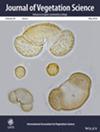The Presence of Alternative Tree Species in European Beech Forests Drives Change in Functional Diversity and Composition of Forest Floor Plant Communities
Abstract
Questions
The diversity and composition of functional traits within plant communities have repeatedly been shown to be important predictors of overall ecosystem stability and the provision of basic ecosystem services. Admixing alternative tree species to monodominant European beech forests, a common measure of silvicultural climate change adaptation, is known to affect species diversity and composition of forest floor vegetation. Here we studied whether this adaptation measure also affects the functional diversity and composition of understorey plant communities.
Location
The study was carried out in temperate beech forests of southwest Germany in Central Europe.
Methods
We used the four key plant traits seed mass (SDM), plant height (PHV), leaf dry-matter content (LDMC) and specific leaf area (SLA) to calculate the distance-based functional richness (FRic), functional evenness (FEve), functional divergence (FDiv) and the community-weighted mean (CWM) plant traits of herb layer plant communities. Generalised mixed models were built to test the effects of gradually admixed Douglas fir (Pseudotsuga menziesii), silver fir (Abies alba), sessile oak (Quercus petraea), red oak (Quercus rubra) and various mixtures of native broadleaves on functional diversity and composition.
Results
The presence of Douglas fir and silver fir was associated with increased FRic of the understorey, silver fir and sessile oak (on base-rich soils only) with increased FDiv, whereas mixed broadleaves were associated with slightly decreased FEve. Regarding CWM trait values, the presence of silver fir (only acidic soils) and sessile oak (only base-rich soils) was linked with increased SDM, Douglas fir, red oak and mixed broadleaves with decreased LDMC. PHV was increased at higher proportions of Douglas fir but lowered in the presence of mixed broadleaves, and SLA was negatively affected by sessile oak presence on acidic soils.
Conclusion
Our results show that herb layer functional diversity and composition are distinctively affected by the diversification of beech forest canopies, which is indicative of environmental changes and might ultimately affect ecosystem functions such as nutrient cycling and litter decomposition. Regarding the conservation of plant communities typical of European beech forests, changes were most unfavourable in non-native red oak and Douglas fir and most favourable in native silver fir and sessile oak.


 求助内容:
求助内容: 应助结果提醒方式:
应助结果提醒方式:


